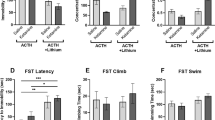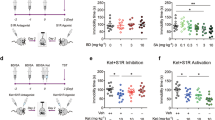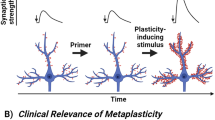Abstract
A single dose of the short-acting NMDA antagonist ketamine produces rapid and prolonged antidepressant effects in treatment-resistant patients with major depressive disorder (MDD), which are thought to occur via restoration of synaptic connectivity. However, acute dissociative side effects and eventual fading of antidepressant effects limit widespread clinical use of ketamine. Recent studies in medial prefrontal cortex (mPFC) show that the synaptogenic and antidepressant-like effects of a single standard dose of ketamine in rodents are dependent upon activation of the mammalian target of rapamycin (mTOR) complex 1 (mTORC1) signaling pathway together with inhibitory phosphorylation of glycogen synthase kinase-3 (GSK-3), which relieves its inhibitory in influence on mTOR. Here, we found that the synaptogenic and antidepressant-like effects of a single otherwise subthreshold dose of ketamine were potentiated when given together with a single dose of lithium chloride (a nonselective GSK-3 inhibitor) or a preferential GSK-3β inhibitor; these effects included rapid activation of the mTORC1 signaling pathway, increased inhibitory phosphorylation of GSK-3β, increased synaptic spine density/diameter, increased excitatory postsynaptic currents in mPFC layer V pyramidal neurons, and antidepressant responses that persist for up to 1 week in the forced-swim test model of depression. The results demonstrate that low, subthreshold doses of ketamine combined with lithium or a selective GSK-3 inhibitor are equivalent to higher doses of ketamine, indicating the pivotal role of the GSK-3 pathway in modulating the synaptogenic and antidepressant responses to ketamine. The possible mitigation by GSK-3 inhibitors of the eventual fading of ketamine’s antidepressant effects remains to be explored.
Similar content being viewed by others
Log in or create a free account to read this content
Gain free access to this article, as well as selected content from this journal and more on nature.com
or
References
Berman RM, Cappiello A, Anand A, Oren DA, Heninger GR, Charney DS et al (2000). Antidepressant effects of ketamine in depressed patients. Biol Psychiatry 47: 351–354.
Berton O, Nestler EJ (2006). New approaches to antidepressant drug discovery: beyond monoamines. Nat Rev Neurosci 7: 137–151.
Beurel E, Song L, Jope RS (2011). Inhibition of glycogen synthase kinase-3 is necessary for the rapid antidepressant effect of ketamine in mice. Mol Psychiatry 16: 1068–1070.
Bradley CA, Peineau S, Taghibiglou C, Nicolas CS, Whitcomb DJ, Bortolotto ZA et al (2012). A pivotal role of GSK-3 in synaptic plasticity. Front Mol Neurosci 5: 13.
Collingridge GL, Peineau S, Howland JG, Wang YT (2010). Long-term depression in the CNS. Nat Rev Neurosci 11: 459–473.
Deguil J, Perault-Pochat MC, Chavant F, Lafay-Chebassier C, Fauconneau B, Pain S (2008). Activation of the protein p7OS6K via ERK phosphorylation by cholinergic muscarinic receptors stimulation in human neuroblastoma cells and in mice brain. Toxicol Lett 182: 91–96.
Diazgranados N, Ibrahim L, Brutsche NE, Newberg A, Kronstein P, Khalife S et al (2010). A randomized add-on trial of an N-methyl-D-aspartate antagonist in treatment-resistant bipolar depression. Arch Gen Psychiatry 67: 793–802.
Duman RS, Aghajanian GK (2012). Synaptic dysfunction in depression: potential therapeutic targets. Science 338: 68–72.
Fekadu A, Wooderson SC, Markopoulo K, Donaldson C, Papadopoulos A, Cleare AJ (2009). What happens to patients with treatment-resistant depression? A systematic review of medium to long term outcome studies. J Affect Disord 116: 4–11.
Freland L, Beaulieu JM (2012). Inhibition of GSK3 by lithium, from single molecules to signaling networks. Front Mol Neurosci 5: 14.
Ghasemi M, Raza M, Dehpour AR (2010). NMDA receptor antagonists augment antidepressant-like effects of lithium in the mouse forced swimming test. J Psychopharmacol 24: 585–594.
Gould TD, Einat H, Bhat R, Manji HK (2004). AR-A014418, a selective GSK-3 inhibitor, produces antidepressant-like effects in the forced swim test. Int J Neuropsychopharmacol 7: 387–390.
Gould TD, Manji HK (2005). Glycogen synthase kinase-3: a putative molecular target for lithium mimetic drugs. Neuropsychopharmacology 30: 1223–1237.
Hoeffer CA, Klann E (2010). mTOR signaling: at the crossroads of plasticity, memory and disease. Trends Neurosci 33: 67–75.
Jernigan CS, Goswami DB, Austin MC, Iyo AH, Chandran A, Stockmeier CA et al (2011). The mTOR signaling pathway in the prefrontal cortex is compromised in major depressive disorder. Prog Neuropsychopharmacol Biol Psychiatry 35: 1774–1779.
Jope RS (2011). Glycogen synthase kinase-3 in the etiology and treatment of mood disorders. Front Mol Neurosci 4: 16.
Kaidanovich-Beilin O, Milman A, Weizman A, Pick CG, Eldar-Finkelman H (2004). Rapid antidepressive-like activity of specific glycogen synthase kinase-3 inhibitor and its effect on beta-catenin in mouse hippocampus. Biol Psychiatry 55: 781–784.
Kaidanovich-Beilin O, Woodgett JR (2011). GSK-3: functional insights from cell biology and animal models. Front Mol Neurosci 4: 40.
Kang HJ, Voleti B, Hajszan T, Rajkowska G, Stockmeier CA, Licznerski P et al (2012). Decreased expression of synapse-related genes and loss of synapses in major depressive disorder. Nat Med 18: 1413–1417.
Lambe EK, Aghajanian GK (2003). Hypocretin (orexin) induces calcium transients in single spines postsynaptic to identified thalamocortical boutons in prefrontal slice. Neuron 40: 139–150.
Li N, Lee B, Liu RJ, Banasr M, Dwyer JM, Iwata M et al (2010). mTOR-dependent synapse formation underlies the rapid antidepressant effects of NMDA antagonists. Science 329: 959–964.
Li N, Liu RJ, Dwyer JM, Banasr M, Lee B, Son H et al (2011). Glutamate N-methyl-D-aspartate receptor antagonists rapidly reverse behavioral and synaptic deficits caused by chronic stress exposure. Biol Psychiatry 69: 754–761.
Little A (2009). Treatment-resistant depression. Am Fam Physician 80: 167–172.
Liu RJ, Aghajanian GK (2008). Stress blunts serotonin- and hypocretin-evoked EPSCs in prefrontal cortex: role of corticosterone-mediated apical dendritic atrophy. Proc Natl Acad Sci USA 105: 359–364.
Ma XC, Dang YH, Jia M, Ma R, Wang F, Wu J et al (2013). Long-lasting antidepressant action of ketamine, but not glycogen synthase kinase-3 inhibitor SB216763, in the chronic mild stress model of mice. PLoS One 8: e56053.
Mathew SJ (2008). Treatment-resistant depression: recent developments and future directions. Depress Anxiety 25: 989–992.
Polter A, Beurel E, Yang S, Garner R, Song L, Miller CA et al (2010). Deficiency in the inhibitory serine-phosphorylation of glycogen synthase kinase-3 increases sensitivity to mood disturbances. Neuropsychopharmacology 35: 1761–1774.
Quiroz JA, Machado-Vieira R, Zarate CA Jr, Manji HK (2010). Novel insights into lithium's mechanism of action: neurotrophic and neuroprotective effects. Neuropsychobiology 62: 50–60.
Yoshihara Y, De Roo M, Muller D (2009). Dendritic spine formation and stabilization. Curr Opin Neurobiol 19: 146–153.
Zarate CA Jr, Brutsche NE, Ibrahim L, Franco-Chaves J, Diazgranados N, Cravchik A et al (2011). Replication of ketamine’s antidepressant efficacy in bipolar depression: a randomized controlled add-on trial. Biol Psychiatry 71: 939–946.
Zarate CA Jr, Singh JB, Carlson PJ, Brutsche NE, Ameli R, Luckenbaugh DA et al (2006). A randomized trial of an N-methyl-D-aspartate antagonist in treatment-resistant major depression. Arch Gen Psychiatry 63: 856–864.
Zoncu R, Efeyan A, Sabatini DM (2011). mTOR: from growth signal integration to cancer, diabetes and ageing. Nat Rev Mol Cell Biol 12: 21–35.
Author information
Authors and Affiliations
Corresponding author
Rights and permissions
About this article
Cite this article
Liu, RJ., Fuchikami, M., Dwyer, J. et al. GSK-3 Inhibition Potentiates the Synaptogenic and Antidepressant-Like Effects of Subthreshold Doses of Ketamine. Neuropsychopharmacol 38, 2268–2277 (2013). https://doi.org/10.1038/npp.2013.128
Received:
Revised:
Accepted:
Published:
Issue date:
DOI: https://doi.org/10.1038/npp.2013.128
Keywords
This article is cited by
-
IGF-1 release in the medial prefrontal cortex mediates the rapid and sustained antidepressant-like actions of ketamine
Translational Psychiatry (2022)
-
Rapid-acting antidepressants and the circadian clock
Neuropsychopharmacology (2022)
-
The role of serotonin neurotransmission in rapid antidepressant actions
Psychopharmacology (2022)
-
Lithium augmentation of ketamine increases insulin signaling and antidepressant-like active stress coping in a rodent model of treatment-resistant depression
Translational Psychiatry (2021)
-
Intra-prefrontal cyclosporine potentiates ketamine-induced fear extinction in rats
Experimental Brain Research (2021)



